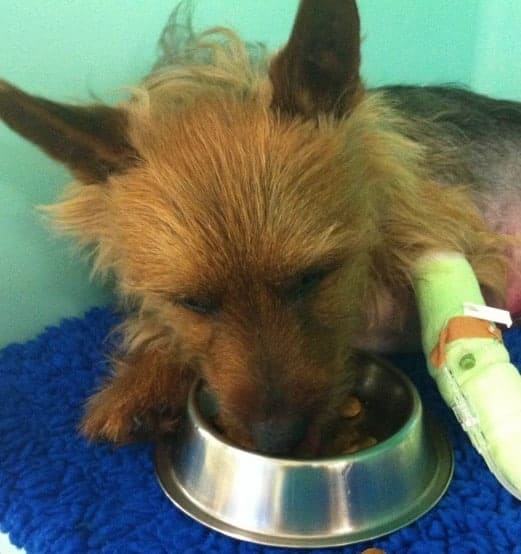WRITTEN BY: Tabatha Whitehead
VN, TAA.

Tabatha Whitehead VN, TAA talks about her own experiences when declining to run some clinical pathology tests on her happy 5 yr old dog, before relenting for training purposes. Here’s Angus’ story.
I still recall that cold raining evening, I was driving home from another long day in the clinic and my fiancé had called to say Angus was not weight bearing on his left hind leg. I sighed, Angus was honestly the most accident prone 5yr old Australian Terrier out there and the fact he’d made it to five without breaking a bone astonished me. I knew finally he’d done something silly.
When I got home I checked his leg out, the cruciate had ruptured completely and he had next-to-no stability in the knee joint. I picked up my phone and called my boss, oncologist Dr Rod Straw. He knew Angus’s antics well, had a chuckle, and said to bring him in the next day. If only it was that simple.

The following day Angus came to work with me, Angus was the kind of dog who loved all attention, even if it was a medical procedure so taking him for surgery wasn’t the least bit stressful. On arrival, the nursing team rolled their eyes at him and chuckled. One of them who was assisting with the surgery that day asked if I’d be running an in-house general health profile on him, I said “Nah, he is happy and healthy, only 5yrs old.” The nurse mentioned we had a trainee who needs to learn to collect blood samples for her Clinical Pathology subject. As Angus loved to be the dog to volunteer to help trainees learn things, I let her go ahead and collect a sample from him to run. I went off to my office to get some rosters written and left them to it. Little did I know our lives would never be the same afterwards.
I heard a tap on my office door – nobody ever knocks on my office door except visitors and students. I look up and the student is standing there with a piece of paper in her hand. She looks terrified and hands it to me. I take the piece of paper, look at it and instantly know we have an issue. My happy, healthy 5yr old dog has liver failure.
Why Clinical Pathology tests are important even for healthy animals.
In laboratory testing, we generally see results with a reference range beside the result. Why the range? Well – this accounts for individual variation in what might be ‘normal’ for a patient. These ranges were established by the manufacturer of the piece of equipment being used via running thousands of samples from patients to establish the average normal results. We know in addition to this normal range, some patients may have parameters fall outside of this range. Is a result falling outside the normal range truly abnormal or more accurately, is this abnormal for this particular patient? Who knows. Furthermore, we can impact the outcome of sample result by our collection methods, storage of the sample and ability to run the test correctly along with interpreting those results. So what do we do about all this? We know as veterinary nurses should have a through understanding about the laboratory samples we collect, store, prepare, run and read the results of. Can you confidently say that pathology is a strength of yours? I’m not sure that many of us can be, yet we perform laboratory tasks every single day in clinic. A skill we should all be strong in is the ability to correctly collect samples and process them.
Back to establishing what is normal or abnormal for a patient, we know as veterinary nurses, that establishing what is normal or abnormal for an individual animal, tends to fall heavily on assessing trends. When it comes to laboratory testing, to obtain a trend for a patient means having two or more occasions that a test may have been run. Yet in clinic often we only run these tests when the patient is showing signs of being unwell. This won’t establish what is normal for this patient, only what the trend might be whilst that patient is clinically unwell. There is a very simple way to establish what is normal for an individual patient, and that is to run these tests whilst the animal is clinically well and unlikely to have systemic disease processes. When should this occur? Whilst the animal is young and healthy of course. Why? A young healthy animal is much more unlikely to have any systemic disease processed going on. If in clinic, we get the opportunity to run at least two basic health tests such as a total annual health profile, or a general health profile for those in house IDEXX test users, along with a complete blood count prior to desexing those 6 month old puppies and kitten, not only do we have the opportunity to ensure that everything is as it physically appears to be in regards to that pets’ health, but we also have begun the process of establishing what is normal for that patient. The AVA has published an excellent document in 2013 entitled the Standards of Care, Regular health check standards for dogs and cats. This document provides some fantastic parameters of what should be examined or measured and when in order to detect changes or record trends for patients throughout their lifespan.
So what happened with Angus?
 Despite extensive work up and treatments, we never resolved nor found the reason for Angus’s liver disease. He passed away a very unwell boy last year. Had I not tested Angus that day before his surgery, the outcome of his general anaesthesia for a simple cruciate surgery might have been dramatically different without the warning of the liver disease. With results like he had, I would not have gone anywhere near him with the routine pre-medicant of Acepromazine and Methadone, without that test I would never have known and he would have been pre-medicated routinely with these drugs. Additionally, had I tested my Angus prior to desexing him some years earlier, I might have had results that showed what was normal for him, these results will have served as a reference point to compare the results we obtained prior to repairing his cruciate. Would that have cured his disease? Maybe, maybe not. We wont have the opportunity to know now. At least we would have had earlier warning of something going wrong and been able to remedy it whilst he was young before the damage was done, or we would have had earlier warning of it and been able to better manage it, preventing the consequential delay to his cruciate repair due to him having to have a full work up with the medical specialists before it was deemed safe to anaesthetise him.
Despite extensive work up and treatments, we never resolved nor found the reason for Angus’s liver disease. He passed away a very unwell boy last year. Had I not tested Angus that day before his surgery, the outcome of his general anaesthesia for a simple cruciate surgery might have been dramatically different without the warning of the liver disease. With results like he had, I would not have gone anywhere near him with the routine pre-medicant of Acepromazine and Methadone, without that test I would never have known and he would have been pre-medicated routinely with these drugs. Additionally, had I tested my Angus prior to desexing him some years earlier, I might have had results that showed what was normal for him, these results will have served as a reference point to compare the results we obtained prior to repairing his cruciate. Would that have cured his disease? Maybe, maybe not. We wont have the opportunity to know now. At least we would have had earlier warning of something going wrong and been able to remedy it whilst he was young before the damage was done, or we would have had earlier warning of it and been able to better manage it, preventing the consequential delay to his cruciate repair due to him having to have a full work up with the medical specialists before it was deemed safe to anaesthetise him.
My experience with Angus has lead to me implementing firm practice policies regarding routine blood work for healthy and young patients now. In my clinic prior to diving into the world of education had routine blood testing as a compulsory component to desexing and strongly recommended at the 6th birthday of all patients. These two tests provided not only the opportunity for early detection of issues, but also serves as a means to record the normal trend for an individual.
If learning more about Pathology routines interests you, you may like to consider our short course on Clinical Pathology. This course will provide you with some excellent knowledge in utilising the equipment, running tests and the intricacies behind obtaining reliable results for your patients.
References
AVA/ASAVA Standards of Care. Regular health check standards for dogs and cats. April 2013.
want to learn more?

CLINICAL PATHOLOGY
SHORT COURSE
This course will ensure you have a good knowledge of laboratory techniques commonly used in the veterinary clinic. You’ll be confident in knowing what equipment is used and how to maintain it including microscopes, refractometers, in-house lab machines, centrifuges etc. We also cover how to perform various pathology procedures urinalysis including sediment, PCV/TP, faecal floats, blood smears, and snap tests etc. The foundations of haematology and biochemistry are also covered, along with the importance of quality assurance procedures. Setting up and assisting with various centesis procedures is also included. Most importantly, you’ll learn about the correct handling and storage of samples to ensure accurate test results.
Check it out